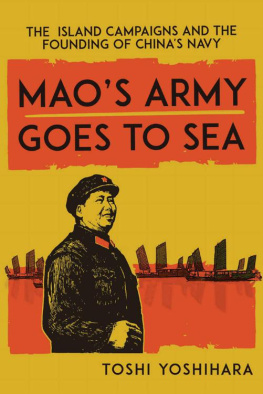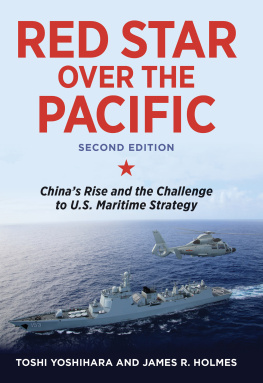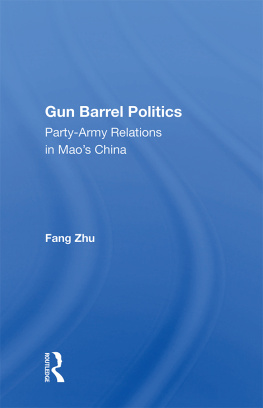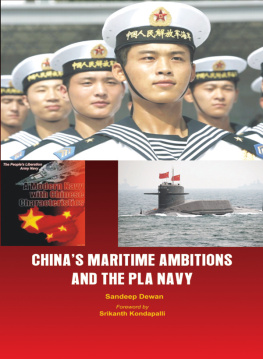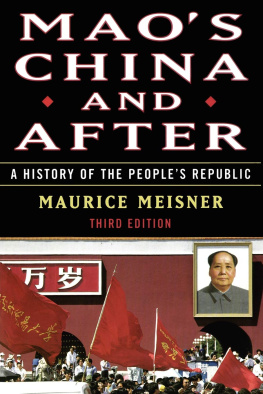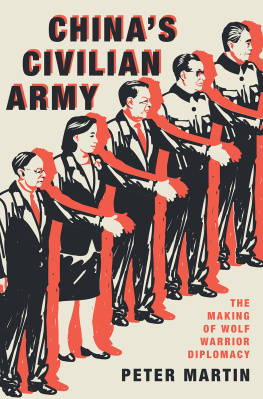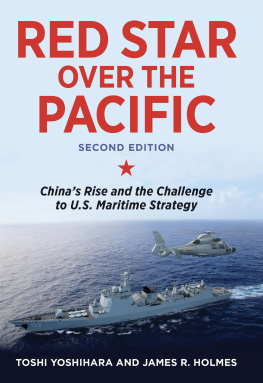Toshi Yoshihara - Maos Army Goes to Sea: The Island Campaigns and the Founding of Chinas Navy
Here you can read online Toshi Yoshihara - Maos Army Goes to Sea: The Island Campaigns and the Founding of Chinas Navy full text of the book (entire story) in english for free. Download pdf and epub, get meaning, cover and reviews about this ebook. year: 2023, publisher: Georgetown University Press, genre: History. Description of the work, (preface) as well as reviews are available. Best literature library LitArk.com created for fans of good reading and offers a wide selection of genres:
Romance novel
Science fiction
Adventure
Detective
Science
History
Home and family
Prose
Art
Politics
Computer
Non-fiction
Religion
Business
Children
Humor
Choose a favorite category and find really read worthwhile books. Enjoy immersion in the world of imagination, feel the emotions of the characters or learn something new for yourself, make an fascinating discovery.
- Book:Maos Army Goes to Sea: The Island Campaigns and the Founding of Chinas Navy
- Author:
- Publisher:Georgetown University Press
- Genre:
- Year:2023
- Rating:4 / 5
- Favourites:Add to favourites
- Your mark:
- 80
- 1
- 2
- 3
- 4
- 5
Maos Army Goes to Sea: The Island Campaigns and the Founding of Chinas Navy: summary, description and annotation
We offer to read an annotation, description, summary or preface (depends on what the author of the book "Maos Army Goes to Sea: The Island Campaigns and the Founding of Chinas Navy" wrote himself). If you haven't found the necessary information about the book — write in the comments, we will try to find it.
Maos Army Goes to Sea: The Island Campaigns and the Founding of Chinas Navy — read online for free the complete book (whole text) full work
Below is the text of the book, divided by pages. System saving the place of the last page read, allows you to conveniently read the book "Maos Army Goes to Sea: The Island Campaigns and the Founding of Chinas Navy" online for free, without having to search again every time where you left off. Put a bookmark, and you can go to the page where you finished reading at any time.
Font size:
Interval:
Bookmark:
MAOS ARMY GOES TO SEA
MAOS ARMY GOES TO SEA
THE ISLAND CAMPAIGNS AND THE FOUNDING OF CHINAS NAVY
TOSHI YOSHIHARA
GEORGETOWN UNIVERSITY PRESS | WASHINGTON, DC
2022 Georgetown University Press. All rights reserved. No part of this book may be reproduced or utilized in any form or by any means, electronic or mechanical, including photocopying and recording, or by any information storage and retrieval system, without permission in writing from the publisher.
The publisher is not responsible for third-party websites or their content. URL links were active at time of publication.
Library of Congress Cataloging-in-Publication Data
Names: Yoshihara, Toshi, author.
Title: Maos army goes to sea : the island campaigns and the founding of Chinas navy / Toshi Yoshihara.
Description: Washington, DC : Georgetown University Press, 2022. | Includes bibliographical references and index.
Identifiers: LCCN 2021062356 (print) | LCCN 2021062357 (ebook) | ISBN 9781647122812 (hardcover) | ISBN 9781647122829 (paperback) | ISBN 9781647122836 (ebook)
Subjects: LCSH: China. Zhongguo ren min jie fang jun. Hai jun. | ChinaHistory, Naval20th century.
Classification: LCC DS739 .Y67 2022 (print) | LCC DS739 (ebook) | DDC 359.00951dc23/eng/20220901
LC record available at https://lccn.loc.gov/2021062356
LC ebook record available at https://lccn.loc.gov/2021062357
 This paper meets the requirements of ANSI/NISO Z39.48-1992 (Permanence of Paper).
This paper meets the requirements of ANSI/NISO Z39.48-1992 (Permanence of Paper).
23 22 9 8 7 6 5 4 3 2 First printing
Printed in the United States of America
Cover design by Jeremy John Parker
Interior design by BookComp, Inc.
For Susan, Teresa, and Dorothy
CONTENTS
This was an unexpected book project. Since the late 1990s, I have been laser-focused on the present and the future of the Chinese navy. Its origins were, at best, an afterthought. For years, I had uncritically accepted the dismissive interpretations of Communist Chinas earliest years at sea. The conventional wisdom held that Chinas maritime thought was largely a Soviet derivative and that the founding naval leadersarmy officers selected for their loyalty to the Chinese Communist Partycontributed little to the nautical enterprise. There was not much interesting or substantive to examine.
My view changed when I took an unanticipated detour through history. I began an intellectual journey after I stumbled across Chinese open sources about the short, sharp clash between China and South Vietnam over the Paracel Islands in 1974. The little-known Chinese victory in that naval battle, minor by Western standards, furnished China a foothold in the South China Sea. I was stunned by the availability of writings on the naval engagement and discovered that the literature provided rich materials on the operational success. I published an article documenting the Chinese perspectives of the campaign for the Naval War College Review in 2016. After dipping my toe in Chinas naval past, I became more intrigued about the Chinese navys origins.
I looked further back in time and came across a large body of works on the Chinese navys founding and Communist Chinas earliest offshore campaigns. Some writings were firsthand accounts by those who participated in the critical first months of Chinas seaward turn. The origin story, as the Chinese have retold it, is far richer than most in the West have presumed. Just as I saw parallels between the 1974 Paracels sea battle and present-day Chinese maritime behavior, I detected patterns in 1949 and 1950 that could have implications for Chinese sea power today. I became convinced that an understanding of Chinas prospects at sea in the twenty-first century requires an acquaintance with its maritime past. This book is the product of these leaps back in time.
I am indebted to many colleagues who made this book possible. I thank Thomas G. Mahnken, president and CEO of the Center for Strategic and Budgetary Assessments, for his unstinting support to the project from its inception to its publication. I am grateful for the terrific feedback on the books earlier draft by Evan Montgomery, director of research and studies at the Center for Strategic and Budgetary Assessments; Ian Easton, senior director at the Project 2049 Institute; Grant Newsham, senior research fellow at the Japan Forum for Strategic Studies; John Schurtz, senior research associate at the Georgia Tech Research Institute; and Brig. Gen. Anthony Henderson, United States Marine Corps whose input was entirely his own and does not represent the views of the Department of Defense, Department of the Navy, or the United States Government. The study benefited from the constructive and learned commentaries by three anonymous reviewers. Special thanks go to Grace Kim, Josh Chang, and Peter Kouretsos for their diligent assistance throughout the course of the research project. Most of all, I thank my wife, Susan, and my two daughters, Teresa and Dorothy, for their love and encouragement.

MAP 0.1. The Offshore campaigns, 19491950
Toshi Yoshihara
This is the story of the Peoples Liberation Armys (PLA) first encounters with the seas. Drawing extensively from Chinese-language sources, Maos Army Goes to Sea recounts the Chinese navys founding and the earliest naval engagements and amphibious operations by Mao Zedongs forces to secure Chinas maritime periphery. The ensuing chapters detail how Maos trusted lieutenants struggled to establish a new naval service and to fight at sea even as the wider Chinese Civil War on the mainland drew to its bitter end. The study further shows that the navy-building process, the pitched battles at sea, and the contested landings on offshore islands had a lasting influence on the Chinese militarys institutions, outlook, strategy, doctrine, and force structure.
In April 1949, Chinese Communist forces crossed the Yangzi River, the last major obstacle to Maos conquest of mainland China. As the PLA swept to victory across southern China amid collapsing Nationalist resistance, Maos armies reached the long coastline facing the East and South China Seas. After making contact with the seas, they found that they had exchanged one set of operational challenges on land for a new kind of problem: the Nationalist threat at sea. To dislodge Nationalist defenders dug in on islands, some no more than a few nautical miles offshore, Communist forces had to learn to operate in an entirely new environment. Over the course of eighteen months from April 1949 to October 1950, Maos subordinates scrambled to stand up a new navy from scratch while launching improvised amphibious operations to drive the Nationalists from offshore islands and ultimately from Taiwan.
AN ARMY GOES TO SEA
This is a remarkable but little-known story in the West. A revolutionary, agrarian-based army, a stranger to sea power, had to adapt to radically new circumstances. Lifelong army officers had to acquaint themselves with nautical affairs and naval tactics, while combat-hardened soldiers, many of whom had never seen the ocean, had to retrain for sea crossings and beach landings. Mao and his senior army commanders too had to puzzle through the unique institutional and material requirements of a new navy. They learned that the naval buildup was not merely a technological question. It had as much to do with cultivating human capital as with forging weaponry. The PLA, moreover, confronted an adversary that still commanded the air and the seas, while Communist forces had virtually no navy, no air force, and no modern industrial base to speak of.
And yet, in less than two years Mao and his commanders notched some significant successes even as they suffered one of the most disastrous defeats in the civil war. The establishment of the East China Navy, the predecessor of the Eastern Theater Navy or East Sea Fleet, served as an institutional laboratory for constructing the national navy, the Peoples Liberation Army Navy (PLAN). The Communists built a makeshift navy that drew its resources, in part, from former Chinese Nationalist Party (Kuomintang [KMT]) officers and sailors and from the civilian sector, including its fishermen and merchantmen and their boats. The naval leadership founded naval academies and established a system for grooming the next generation of seagoing officers and troops in lightning speed. By the fall of 1950, the Chinese navy had developed a long-term vision and a concrete buildup plan. But war on the Korean Peninsula and Maos subsequent decision to intervene in the conflict abruptly changed Beijings priorities and substantially curtailed the navys program.
Next pageFont size:
Interval:
Bookmark:
Similar books «Maos Army Goes to Sea: The Island Campaigns and the Founding of Chinas Navy»
Look at similar books to Maos Army Goes to Sea: The Island Campaigns and the Founding of Chinas Navy. We have selected literature similar in name and meaning in the hope of providing readers with more options to find new, interesting, not yet read works.
Discussion, reviews of the book Maos Army Goes to Sea: The Island Campaigns and the Founding of Chinas Navy and just readers' own opinions. Leave your comments, write what you think about the work, its meaning or the main characters. Specify what exactly you liked and what you didn't like, and why you think so.

